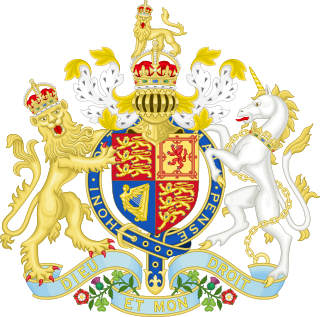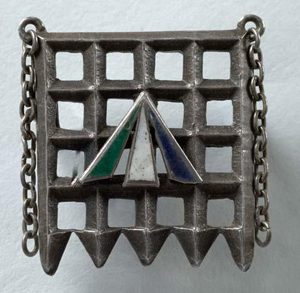Related Research Articles

Emmeline Pankhurst was a British political activist who organised the British suffragette movement and helped women to win in 1918 the right to vote in Great Britain and Ireland. In 1999, Time named her as one of the 100 Most Important People of the 20th Century, stating that "she shaped an idea of objects for our time" and "shook society into a new pattern from which there could be no going back". She was widely criticised for her militant tactics, and historians disagree about their effectiveness, but her work is recognised as a crucial element in achieving women's suffrage in the United Kingdom.

The Prisoners Act 1913, commonly referred to as the Cat and Mouse Act, was an Act of Parliament passed in Britain under H. H. Asquith's Liberal government in 1913.

Dame Christabel Harriette Pankhurst was a British suffragette born in Manchester, England. A co-founder of the Women's Social and Political Union (WSPU), she directed its militant actions from exile in France from 1912 to 1913. In 1914, she supported the war against Germany. After the war, she moved to the United States, where she worked as an evangelist for the Second Adventist movement.

The Women's Social and Political Union (WSPU) was a women-only political movement and leading militant organisation campaigning for women's suffrage in the United Kingdom founded in 1903. Known from 1906 as the suffragettes, its membership and policies were tightly controlled by Emmeline Pankhurst and her daughters Christabel and Sylvia. Sylvia was eventually expelled.

Rachel Barrett was a Welsh suffragette and newspaper editor born in Carmarthen. Educated at the University College of Wales in Aberystwyth she became a science teacher, but quit her job in 1906 on hearing Nellie Martel speak of women's suffrage, joined the Women's Social and Political Union (WSPU) and moved to London. In 1907, she became a WSPU organiser, and after Christabel Pankhurst fled to Paris, Barrett became joint organiser of the national WSPU campaign. In 1912, despite no journalistic background, she took charge of the new newspaper The Suffragette. Barrett was arrested on occasions for activities linked to the suffrage movement and, in 1913–1914, spent some time incognito to avoid re-arrest.

Marion Wallace Dunlop was a Scottish artist, author and illustrator of children's books, and suffragette. She was the first and one of the most well known British suffrage activists to go on hunger strike on 5 July 1909, after being arrested in July 1909 for militancy. She was at the centre of the Women's Social and Political Union and designed some of the most influential processions of the UK suffrage campaign, as well as designing banners for them.

Black Friday was a suffragette demonstration in London on 18 November 1910, in which 300 women marched to the Houses of Parliament as part of their campaign to secure voting rights for women. The day earned its name from the violence meted out to protesters, some of it sexual, by the Metropolitan Police and male bystanders.

A movement to fight for women's right to vote in the United Kingdom finally succeeded through acts of Parliament in 1918 and 1928. It became a national movement in the Victorian era. Women were not explicitly banned from voting in Great Britain until the Reform Act 1832 and the Municipal Corporations Act 1835. In 1872 the fight for women's suffrage became a national movement with the formation of the National Society for Women's Suffrage and later the more influential National Union of Women's Suffrage Societies (NUWSS). As well as in England, women's suffrage movements in Wales, Scotland and other parts of the United Kingdom gained momentum. The movements shifted sentiments in favour of woman suffrage by 1906. It was at this point that the militant campaign began with the formation of the Women's Social and Political Union (WSPU).

A suffragette was a member of an activist women's organisation in the early 20th century who, under the banner "Votes for Women", fought for the right to vote in public elections in the United Kingdom. The term refers in particular to members of the British Women's Social and Political Union (WSPU), a women-only movement founded in 1903 by Emmeline Pankhurst, which engaged in direct action and civil disobedience. In 1906, a reporter writing in the Daily Mail coined the term suffragette for the WSPU, derived from suffragistα, in order to belittle the women advocating women's suffrage. The militants embraced the new name, even adopting it for use as the title of the newspaper published by the WSPU.

Mary Leigh was an English political activist and suffragette.

Jessica "Jessie" Kenney (1887–1985) was an English suffragette who was jailed for assaulting the Prime Minister and Home Secretary in a protest to gain suffrage for women in the UK. Details of a bombing campaign to support their cause were discovered by the authorities in her flat when Kenney was sent abroad to convalesce. She later trained as a wireless operator but worked as a stewardess.

Marie Venetia Caroline Brackenbury (1866–1950) was a British painter who was a militant suffragette and suffragette artist. She was jailed for demonstrating for women's rights. She followed Emmeline Pankhurst's lead as she became more militant. Her home was known as "Mouse Castle" because it looked after recovering hunger strikers. The house now has a plaque which remembers the trio of her sister, her mother and Maria. She was the younger sister of Georgina Brackenbury, also a painter and militant suffragette.

Florence Eliza Haig (1856–1952) was a Scottish artist and suffragette who was decorated for imprisonments and hunger strikes.

Maud Joachim was a member of the Women's Social and Political Union, one of the groups of suffragettes that fought for women to get the right to vote in the United Kingdom. She was jailed several times for her protests. Joachim was one of the first suffragettes to go on hunger strike when imprisoned, a protest at not being recognised as political prisoners.

Joan Lavender Bailie Guthrie or Laura Grey (1889–1914) was a British suffragette, actress, and member of the Women's Social and Political Union (WSPU).

Edith Hudson was a British nurse and suffragette. She was an active member of the Edinburgh branch of the Women's Social and Political Union (WSPU) and was arrested several times for her part in their protests in Scotland and London. She engaged in hunger strikes while in prison and was forcibly fed. She was released after the last of these strikes under the so-called Cat and Mouse Act. Hudson was awarded a Hunger Strike Medal 'for Valour' by the WSPU.

Eleanor Grace Watney Roe was Head of Suffragette operations for the Women's Social and Political Union. She was released from prison after the outbreak of World War I due to an amnesty for suffragettes negotiated with the government by the WSPU.

The Holloway brooch was presented by the Women's Social and Political Union (WSPU) to women who had been imprisoned at Holloway Prison for militant suffragette activity. It is also referred to as the "Portcullis badge", the "Holloway Prison brooch" and the "Victoria Cross of the Union".

The Hunger Strike Medal was a silver medal awarded between August 1909 and 1914 to suffragette prisoners by the leadership of the Women's Social and Political Union (WSPU). During their imprisonment, they went on hunger strike while serving their sentences in the prisons of the United Kingdom for acts of militancy in their campaign for women's suffrage. Many women were force-fed and their individual medals were created to reflect this.
Elizabeth Ellen Hesmondhalgh began working around 1885 as a cotton spinner in Preston, and became a British suffragette, imprisoned twice for militant protesting on behalf of women's franchise, and awarded the Women's Social and Political Union (WSPU) Hunger Strike Medal for valour.
References
- ↑ Cowman, Krista (15 July 2007). Women of the Right Spirit: Paid Organisers of the Women's Social and Political Union (WSPU), 1904-18. Manchester University Press. p. 139. ISBN 978-0-7190-7002-0.
- 1 2 3 4 "Ellen Pitfield". Mapping Women's Suffrage. Retrieved 19 November 2024.
- 1 2 Meeres, Frank (15 May 2013). Suffragettes: How Britain’s Women Fought & Died for the Right to Vote. Amberley Publishing Limited. pp. 67–68. ISBN 978-1-4456-2057-2.
- ↑ Morrell, Caroline (1981). 'Black Friday' and Violence Against Women in the Suffragette Movement. Women's Research and Resources Centre. ISBN 978-0-905969-08-4.
- ↑ Heagerty, Brooke Victoria (1990). Class, Gender, and Professionalization: The Struggle for British Midwifery, 1900-1936. Michigan State University. Department of History. p. 59.
- 1 2 3 Godfrey, Jennifer (4 July 2024). Secret Missions of the Suffragettes: Glassbreakers and Safe Houses. Pen and Sword History. ISBN 978-1-3990-1397-0.
- ↑ "A Soldier to the Death". The National Archives. Retrieved 19 November 2024.
- ↑ Rosen, Andrew (17 January 2013). Rise Up, Women!: The Militant Campaign of the Women's Social and Political Union, 1903-1914. Routledge. p. 158. ISBN 978-1-136-24754-5.
- ↑ Atkinson, Diane (2019). Rise Up, Women!: The Remarkable Lives of the Suffragettes. Bloomsbury Publishing. p. 301. ISBN 978-1-4088-4405-2.
- ↑ Pankhurst, Estelle Sylvia (1977) [1934]. The suffragette movement : an intimate account of persons and ideals. London : Virago – via Internet Archive.
- ↑ Jorgensen-Earp, Cheryl R. (1999). Speeches and Trials of the Militant Suffragettes: The Women's Social and Political Union, 1903-1918. Fairleigh Dickinson University Press. p. 123. ISBN 978-0-8386-3788-3.
- ↑ The British Journal of Nursing with which is Incorporated the Nursing Record. Vol. 48. 1912. p. 310.